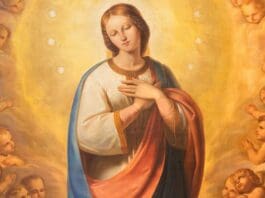
Following Jewish customs, the parents of our Lady named her eight days after her birth. They felt inspired to name her Mary. Due to this, the Feast of the Holy Name of Mary comes after her Birthday, just as the Feast of the Holy Name of Jesus comes after Christmas.
The feast, celebrating Mary’s name, began in Spain and was recognized by the Holy See in 1513. Later in 1683, Innocent XI extended its observance to the entire Church. This extension was a gesture of gratitude to our Lady for a significant victory on September 12, 1683. On this day, King John Sobieski of Poland triumphed over the Turks, who were not only besieging Vienna but were also threatening the entirety of the West.
To commemorate this victory in Vienna, a unique pastry was created. This pastry was shaped like the Turkish half-moon, representing the defeated invaders. Moreover, coffee, a part of the spoils from the Turks, was consumed with this pastry.
Early Christian writings, retained by the ancient Onomastica Sacra and perpetuated by the Greek Fathers, provide varied interpretations of Mary’s name. Among the prominent ones are “Bitter Sea,” “Myrrh of the Sea,” “The Light Giver,” “The Enlightened One,” “Lady,” “Seal of the Lord,” and “Mother of the Lord.” The root assumption for these interpretations is that the Hebrew version of the name is Maryãm, not Miryãm.
Between the time of St. Jerome and the 16th century, popular interpretations of Mary’s name in the West included “Lady,” “Bitter Sea,” “The Light Giver,” and most prominently, “Star of the Sea.” Stella Maris was the most favored interpretation.
However, the Renaissance brought about a revival of Hebraic studies, leading scholars to re-examine the meanings attributed to our Lady’s name. Miryãm appears to be a genuine Hebrew name, and there hasn’t been any concrete reason to dispute its Semitic origin. In Hebrew, Mary’s name, Miryãm (or Domina in Latin), translates to “lady” or “sovereign.” This underlines her significance in relation to her Son’s sovereign authority. Thus, when we refer to Mary as our Lady, just as we refer to Jesus as our Lord, we acknowledge her power, seek her assistance, and place ourselves under her protective care.
Editorial credit: Renata Sedmakova / Shutterstock.com
The post Most Holy Name of Mary appeared first on uCatholic.
Daily Reading
Saturday of the Thirty-second Week in Ordinary Time
Reading 1 3 JN 5-8 Beloved, you are faithful in all you do for the brothers and sisters, especially for strangers; they have testified to your love before the Church….
Daily Meditation
Set Your Hearts on Christ
Click here for daily readings Today’s Gospel passage is part of a conversation between Jesus and the apostles in the Temple. It began with the apostles walking through the city…




